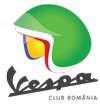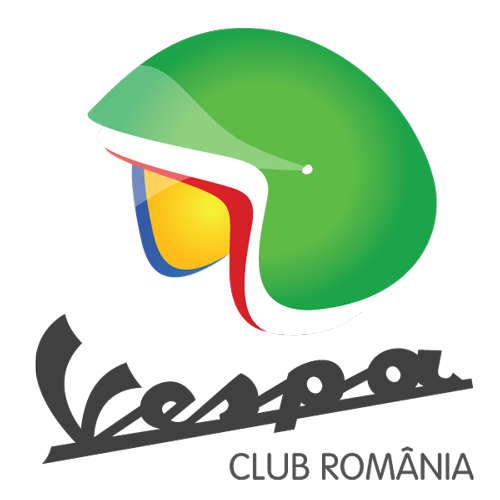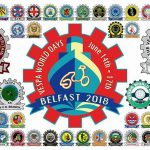VESPA 98
1946
In April 1946, this amazing new, functional and innovative mode of transport was presented to the general public for the first time in a Golf Club in Rome. The shield was embossed with a new logo which replaced the previous Piaggio Aircraft emblem. Vespa was an immediate success and gained extensive media interest as well as public curiosity, surprise and even skepticism. The first sales of Vespa were managed through a small dealer network and the price of the standard model was 55,000 lire, while the deluxe version was sold for 66,000 lire.

VESPA 98 CORSA CIRCUITO
1947
The Vespa 98 Corsa was built specifically to show the world that the capacity of the small scooter could be competitive in races. The great swarm of Vespa which was growing in the streets and squares of Italy, motivated Enrico Piaggio to produce an aggressive vehicle, which could be an on-track winner. The first to ride the Vespa 98 on circuit was Giuseppe Cau who triumphed in the Monte Mario Hill Climb in 1947. The Vespa 98 Corsa (Circuit) was built for speed and stood for innovation. The body was hand-built with a steel frame. The brakes were drum, equipped with rear air vents for cooling. The gearbox was a three-speed unit, which enabled throttle control and cooling happened through a forced air ventilation. Its original color was red, that’s why this model was also known as the small „fireball”.
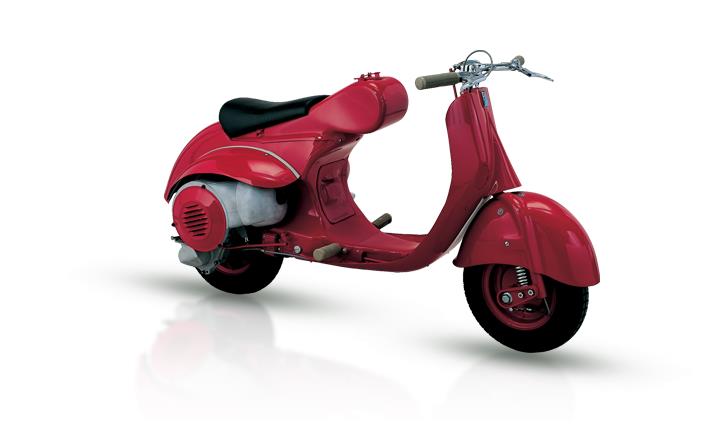
VESPA 98 II SERIE
1947
16,500 models of the second series of Vespa 98 were ever produced. This model offered significant improvements over its predecessor both in aesthetics and technical specifications. As well as this it now featured a spare wheel just in case the rider got a puncture, which was highly likely due to the awful post-war road conditions; this highly-functional element soon became one of Vespa’s most recognizable design features. The Vespa 98 was introduced with a new and improved headlamp and a metallic silver color which reminded of the Piaggio aircraft business. Magazines reported there would be a waiting list of 8 months to get a Vespa 98: a thriving black market blossomed, in which Vespa was sold twice the starting price, even reaching a price of 125,000 lire!

VESPA 125 CORSA “ALLOY FRAME”
1949
In 1949 Vespa was first built with a race chassis which was made from the same aluminium alloy used for the construction of aircraft and was assembled with rivets, alloy wheels and technology which was highly advanced during the 40’s.
The fuel tank and steering position gave the rider more autonomy which resulted in the optimisation of high speed riding. Vespa 125cc Corsa participated to many competitions and celebrated many prestigious victories in 1950, with the riders Giuseppe Cau and Dino Mazzoncini achieving the first and second place in the Grand Prix of Bologna; In the same year Cau also won at the Circuit of Perugia riding Vespa 125 in the race No. 38. Worldwide only six copies of this model along with some prototypes were ever produced by Piaggio.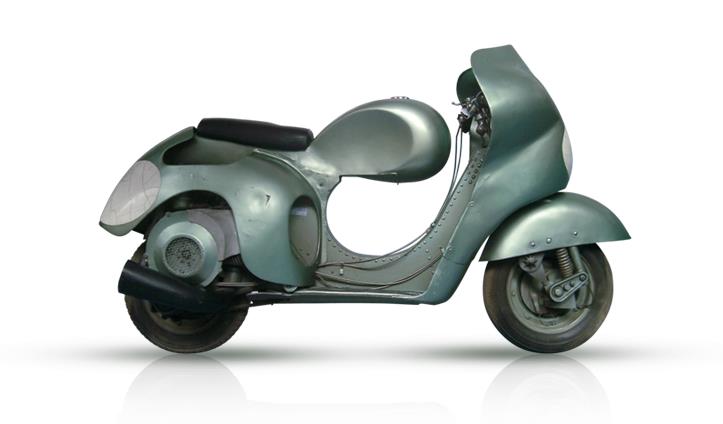
VESPA125
1949
In 1948 Piaggio launched a new Vespa. Between 1946 and 1947, 1183 Vespas 125cc were sold and marketed abroad (particularly in Switzerland). At the end of 1947 Enrico Piaggio decided to completely stop the production of Vespa 98cc and to only continue with the 125cc for the Italian and international markets. Some other model adaptations included the front suspension arm and the engine hood, which was lifted up to permit an easier access to the engine and to other mechanical components. The next series of the 1949 Vespa, which is today on display in the Piaggio Museum, looked even better with the new cooling system and the renewed gearbox controls.
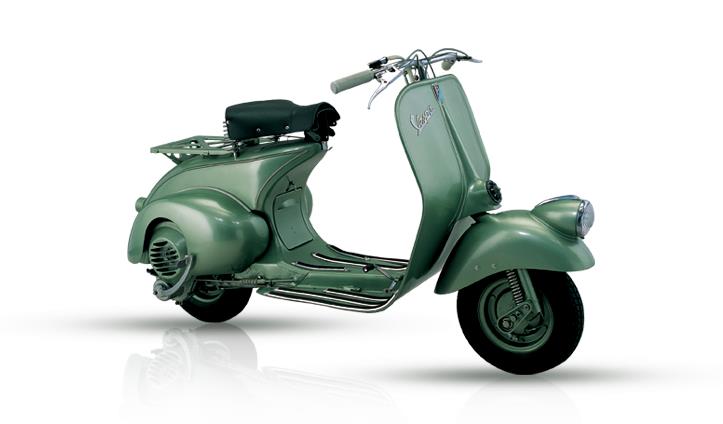
VESPA CIRCUITO 125
1949
In the late forties the major motorcycle manufacturers considered the best way to advertise their vehicles to participate to several races. The aim was to bring the motorcycling industry to the general public with the hope of creating new potential customers. Also the Piaggio scooters took part to races in a series of circuits; this was for the purpose of advertising the motorcycles, but the 125 circuit also proved to be an useful arena for testing new solutions ,which led to adaptations of the standard models. Vespa racing scooters were completely handmade and built by specialists within Piaggio and were used in races by lots of major riders such as Dino Mazzoncini and Giuseppe Cau. Giuseppe Cau won the time trail race at the Catania Etna in 1950, arriving first in his class (125cc) and placed at the 3rd place in the overall standings after Guzzi and Benelli.

VESPA MONTLHERY
1950
To promote the sporty image of Vespa, Piaggio shifted the focus towards breaking new records. On April 7th, 1950, at the French circuit of Montlhery, during 10 hours of testing with three drivers alternating riding, Vespa won the world record for the 100 mile race (average speed 129.7 km/h), 500 mile race (average speed 123.9 km/h), and the 1,000 km race (average speed 124.3 km/h). During the 10 hours the Vespas covered 1,049 kilometers (652 miles). With a very similar vehicle to the 1949 Vespa 125 „circuit” with alloy frame, Mazzoncini achieved brilliant results in circuit racing, with a victory in the scooter class at the Circuit of Genoa, holding off the challenging Lambretta.

VESPA SILURO (TORPEDO)
1951
In 1951 Vespa broke its most prestigious record: the flying kilometer. On February 9th, between the 10th and the 11th kilometer of the motorway of Rome (near to Ostia), a Vespa engine with two opposed pistons (17.2 hp and 9500 rpm), designed by Corradino D’Ascanio, and led by Dino Mazzoncini, run the flying kilometer with a record time of 21.4 seconds with an average speed of 171.1 km/ h (106.25 mph).
-1951.jpg)
VESPA 125
1951
Very similar to the pattern of 1948, the sales during 1951 were on the increase due to improved technology and aesthetics. The model of 1951 even became famous in its cinema debut in the romantic and unforgettable movie Roman Holiday which told the love story of Audrey Hepburn and Gregory Peck in Rome.

VESPA 125 “SIX DAYS”
1951
Aesthetically very similar to Vespa 125, the „Six Days” differed due to the fuel tank benefitting of a wraparound shield and the right side bag which accommodated a larger carburetor. The name came from the participation at the Twenty-sixth International Six Days in 1951, where nine gold medals were won. The Piaggio Racing Team was composed of: Biasci, Cau, Crabs, Mazzoncini, Merlo, Nesti, Opesso, Riva, Romano and Vivaldi. The Vespa 125 „six days” also won the trophy of the Italian Motorcycle Federation in 1951, which saw three riders dominate on Italian Vespas (Giuseppe Cau, Miro Riva, Bruno Romano).

VESPA 125 U
1953
Only 7,000 units of the U Vespa scooter were ever produced, making this model one of the most sought after by collectors. Created in 1953 as the economic model – the letter „U” stands for utility – it was designed to counteract Lambretta’s competition and got sold on the market for 110 dollars. For the first time the headlight was mounted at the height of the handlebars instead of the front fender.
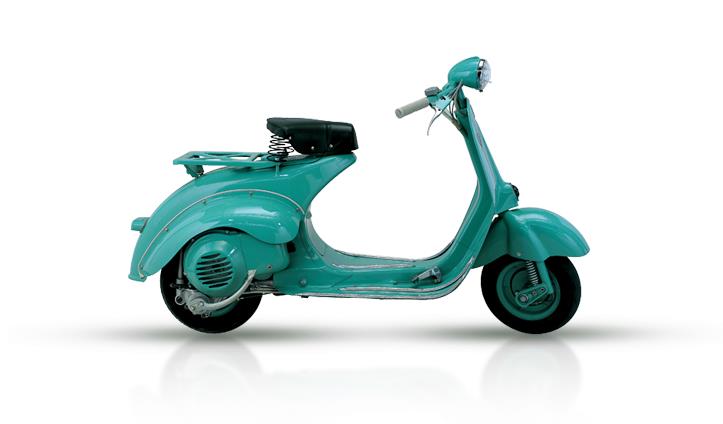
VESPA 150 SIDE-CAR
1955
The Vespa sidecar was created between the late 1948 and the early 1949. The Vespa with sidecar enabled a stable and comfortable travel over long distances. The sidecar was made of sheet steel and was assembled by hand and attached to the Vespa with a single tube. Commended for their excellent performance, even on snowy terrain and on steep slopes, the side-car model dictated itself to comfort, additional capacity thanks to a small trunk at the rear and the additional convenience on long pursuits.
VESPA 150 GS
1955
The GS 150 was a milestone in the history of the scooter, not only for Vespa but for the market as a whole. It’s remembered as the most beautiful scooter ever produced in the world and is now highly sort after. In the ’50s the market also changed and Vespa became a symbol for young people to distinguish themselves. For the first time a vehicle for the mass market was created with a quieter engine and breathtaking performance. The Vespa 150 GS had sporty credentials which where a direct result of the experience of the Piaggio racing team. The engine had a direct admission into the cylinder and was capable of 8 hp at 7500 rpm, the gearbox had four gears. The elongated seat and the large 10-inch wheels fundamentally altered the Vespa line. A pre-series version of this model is now on display at the Piaggio Museum.
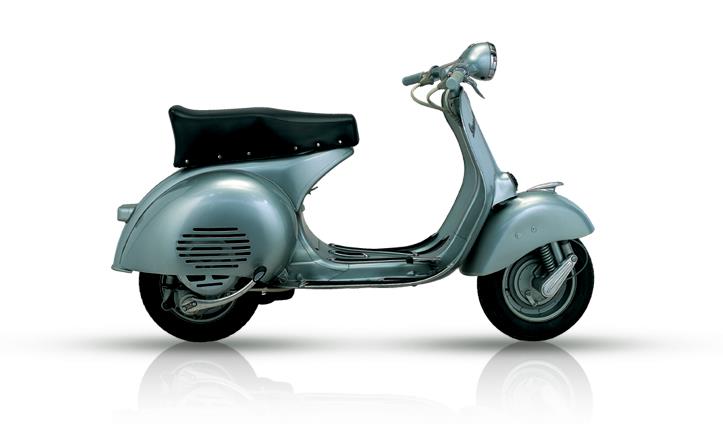
VESPA 150
1956
In 1956, ten years after the birth of the first model, the Pontedera factory achieved the millionth Vespa sale. Vespa’s success went beyond all expectations: the legendary scooter was now offered in three versions: 125cc, 150cc and the 150cc GS. The Vespa 150 provided improved performance and it also stood out due to the headlamp mounted high above the handlebars. The launch price of the Vespa 150 in 1956 was 148,000 lire.
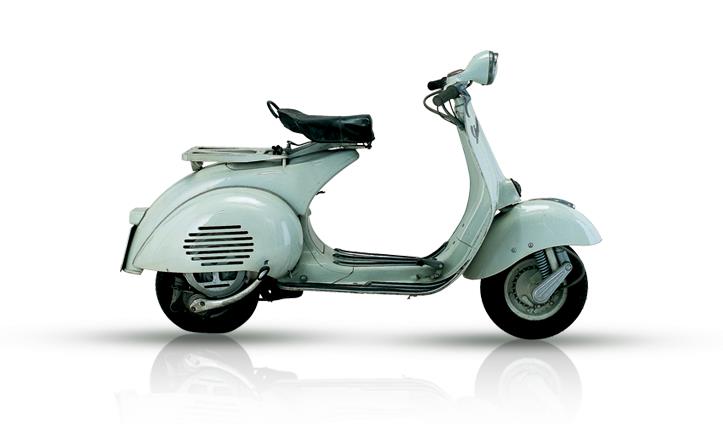
VESPA 150 T.A.P.
1956
The French Ministry of Defense, in the fifties, commissioned by the licensee in Piaggio France (ACMA) requested the development of a vehicle for military use. The result was a very special Vespa of which there were only about 600 produced from 1956 to 1959. Used by the Foreign Legion and the Parachute Corps, the Vespa TAP was equipped with a 75mm gun, capacity for additional ammunition, two cans of fuel and a small cart. It was produced in two camouflage colors: green and sand. Despite the weight of 115 kg the Vespa TAP could reach a speed of 66 km / h, with a range of 200 km (124 mi).

VESPA 400
1957
At the peak of Vespa’s success, Piaggio decided to access the four wheels world.
It was always the goal of Corradino D’Ascanio to design the small Vespa 400, a car with a two-stroke engine in the rear. It was launched in 1957 and Piaggio produced 30,000 units of this model.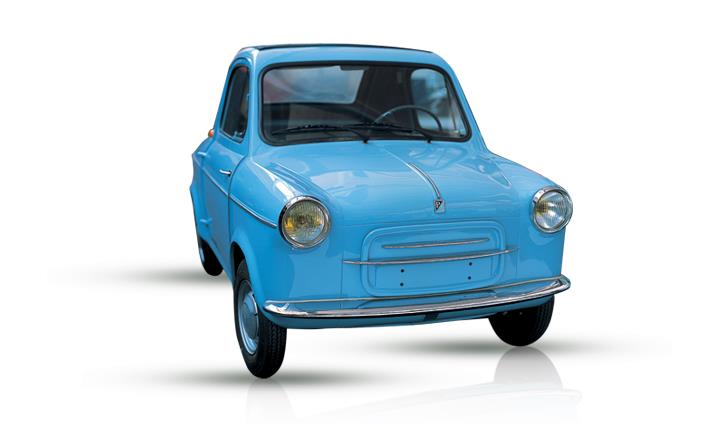
VESPA 125 (VNA2)
1958
Produced in two colors, grey and beige, the 1958 Vespa 125cc marked a new era. This was the first Vespa with a body which was made by the conjunction of two sheet metal halves. This type of frame had considerable advantages in terms of industrial production and from 1958 started to be used on all models. With the new design a new compact engine was also integrated.
-%201958.jpg)
VESPA 150 GS VS5
1959
The legendary Vespa 150 Gran Sport established itself in 1955 with the model VS1. This model was adapted and the VS5 version was equipped with a special speedometer fan and a fully chromed tail light with integrated brake light. It also had an improved braking system and the Piaggio crest on the front fender. The Vespa 150 GS (VS5) model holds the record for the number of units built (80,000) and was produced between 1958 and 1961.
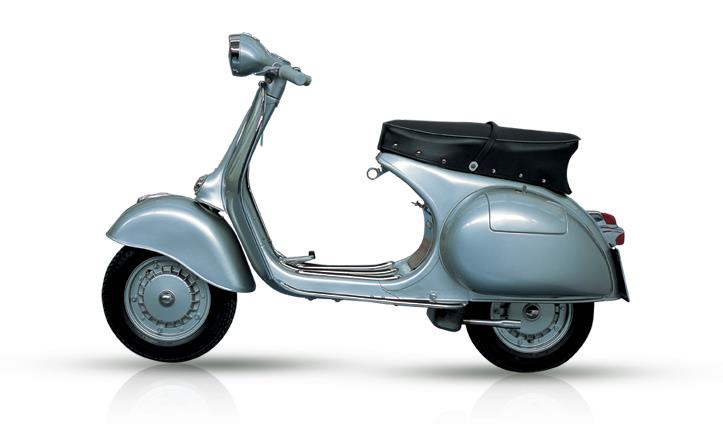
VESPA 150 (VBA)
1961
The Vespa 150 (VBA) was presented in 1958 with a few changes. The color was similar to its predecessors (metallic blue), however the side panels were decorated with aluminum air vents and the rear light was larger and fully chromed. This model made its debut during the Olympic Games in Rome in 1960 and became a great success thanks to its elegance and functionality.
-%201961.jpg)
VESPA DALÌ
1962
In the summer of 1962, the Vespa model that’s probably the most valuable in the world was used to transport two students: Santiago Guillen and Antonio Veciana. The two young men met the master of surrealism, Salvador Dali. Dali, while writing a contemporary chronicle, decorated the body of the Vespa, affixing his signature and name of his wife and muse Gala. In the summer of 1999 in Girona (Spain) during „Eurovespa”, it was exhibited at „The Art of Motorcycle” and was then kindly donated to the Piaggio Museum by Giovanni Alberto Agnelli.
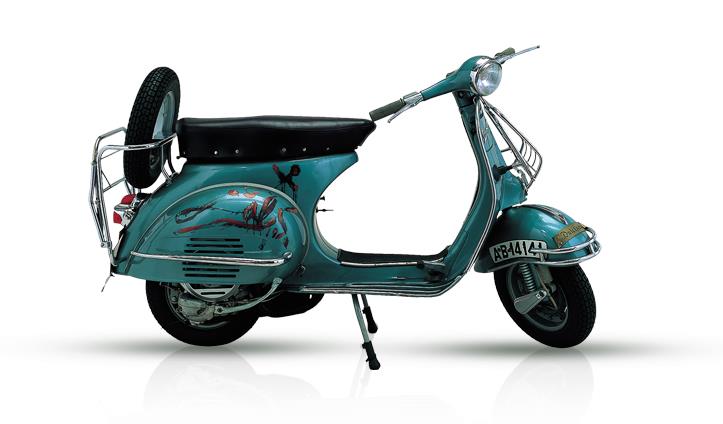
VESPA 50
1963
Vespa became highly popular among young riders, who chose it to for being easily manageable and aesthetically pleasing. In order to attract a wider audience, Piaggio introduced the Vespa 50, which was promoted with the slogan „Young, Modern and … without documents”. It was a Vespa that, according to the rules of the Highway Code in 1963, could be driven without plates and without a license starting from the age of 14. The Vespa 50 was the last scooter designed by Corradino D’Ascanio and the 50cc is a landmark in the history of Vespa: from 1964 to the present, more than 3 million 50cc models have been produced.
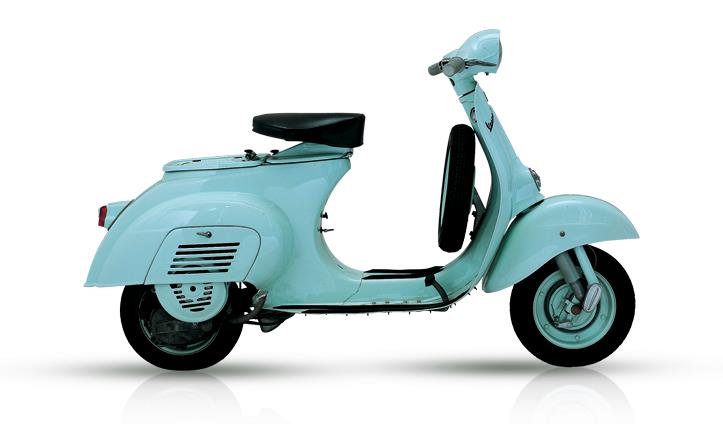
VESPA 90 SUPER SPRINT
1966
The Super Sprint 90 model was undoubtedly the most original designed by Vespa. The shield got reduced in size and the top box objects were placed between the seat and the handlebars. The spare wheel, like for the Vespa GS 1955, was housed within the center of the footrest platform. The 90 SS, like the Vespa 50, is among the most sought after models and is a real collectors item.
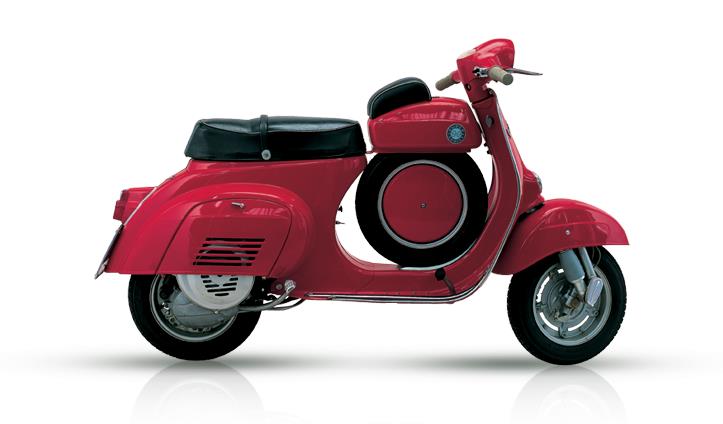
VESPA ALPHA
1967
This vehicle was used in the movie „Dick Smart, Agent 2007” with Richard Wyler, Margaret Lee and Rosanna Tapados. This is a Vespa 180 Super Sport transformed by Piaggio and the English Alpha Willis. This scooter in the movie was capable of running on the road, flying like a helicopter as well as being a submarine.
VESPA 125 PRIMAVERA
1967
Derived from the 125 VMA1, the Vespa 125 „Primavera” since was an immediate success. Performance, agile handling, and a powerful engine were all attributes that made the Vespa Primavera such a success in the sixties. The Primavera was aimed at young people and Piaggio developed the slogan, „With a Vespa you can be” for its launch. It was aimed at 16 year olds who loved sports and living outdoors and who did not want to be late for socializing with friends due to city traffic. The main feature of this scooter was the longer chassis, which made it even easier to carry a passenger.
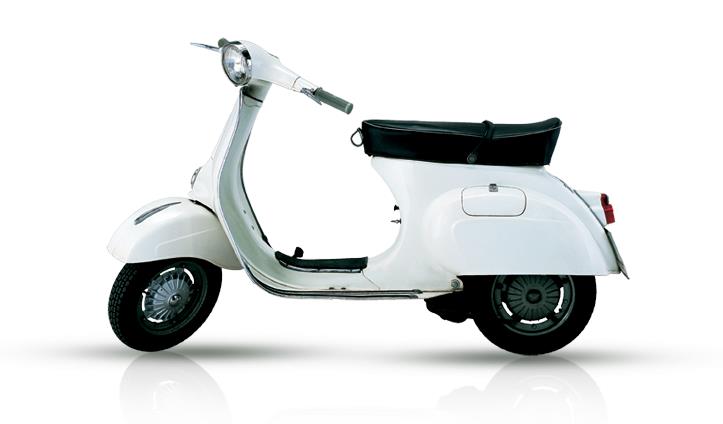
VESPA 180 RALLY
1968
After the success of the Vespa Super Sport 180, Piaggio developed a new high spec 180cc, with a completely new engine and chassis with cosmetic changes to the handlebars and saddle. The Vespa Rally 180 still remains one of the most successful models, produced from 1968 to 1973, with a total of over 26,000 vehicles built.
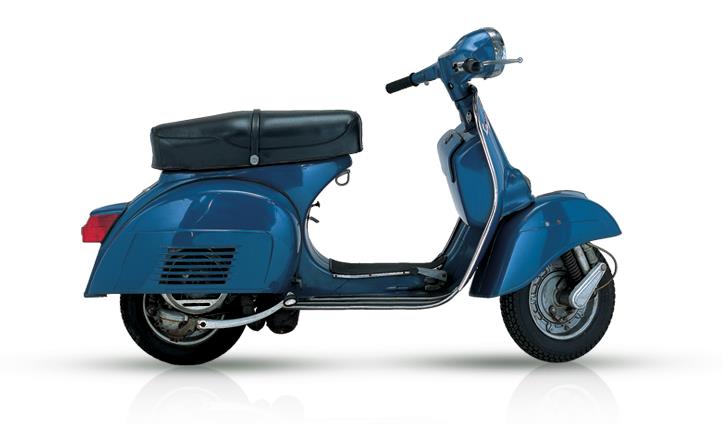
VESPA 50 WITH PEDALS
1970
The Vespa 50, to be marketed in France, underwent a transformation in order to adapt to French regulations. This new scooter had to be adapted by Piaggio to enable the mounting of pedals, as French law stated that pedals must be present on all two-wheeled vehicles. This particular item highly attracted public curiosity and made this model collectable.
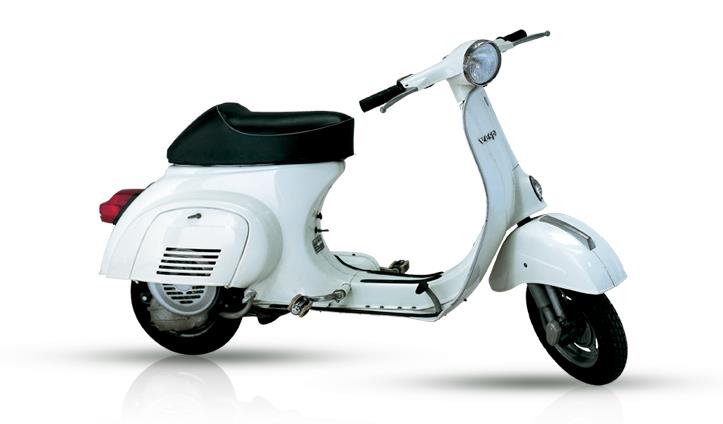
VESPA 50 SPECIAL
1973
Marketed since 1969, the Vespa 50 Special was predominantly presented for the youth market with cosmetic changes to the handlebars, the headlamp, and the tail light. In 1969, the Vespa 50 Elestart was also launched. It kept the same design as the Special, but had an innovative technical adaptation: the electric ignition. From 1969 to 1973, Piaggio launched one its most famous campaigns: „Who ‘Vespas’ eats apples” which referred to the success of the Vespa 50 special.
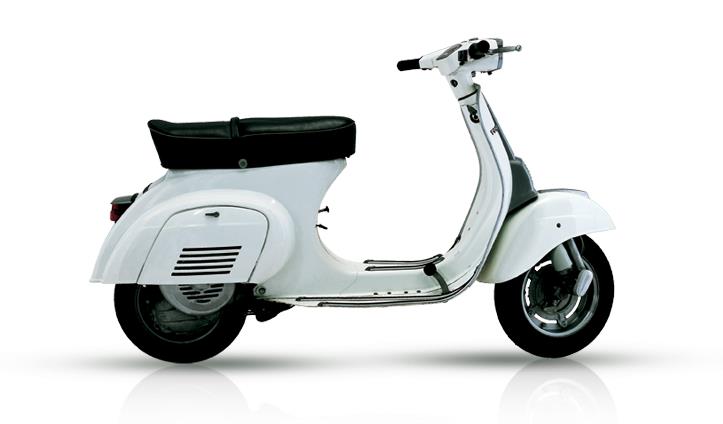
VESPA 125 ET3
1976
Commissioned specifically for the export market, the Vespa ET3 125 had the same features of the Italian ET3, together with the seat, the fan cover and the range of colors. It was particularly popular in Japan, where it remained on sale until the mid-nineties.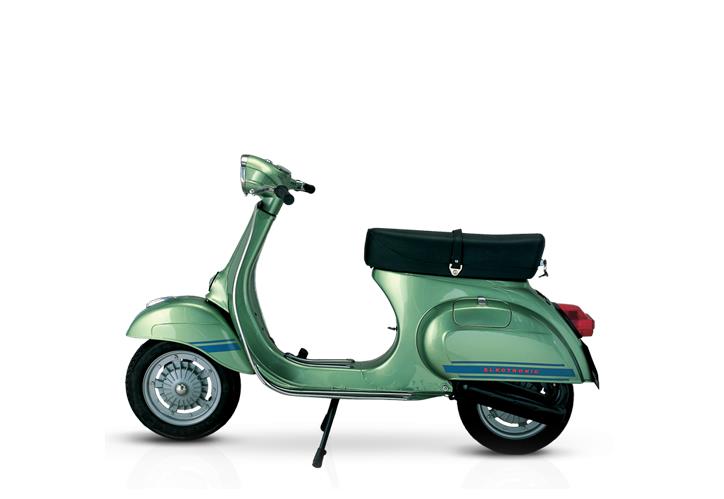
VESPA PRIMAVERA ET3
1976
The Vespa ET3 Primavera was a particular success with 144,000 units produced. The small size of the body, similar to the Vespa 50cc, ensured an agile maneuverability and an excellent road handling. It was developed in the 70’s for the youth market and included details like a denim saddle.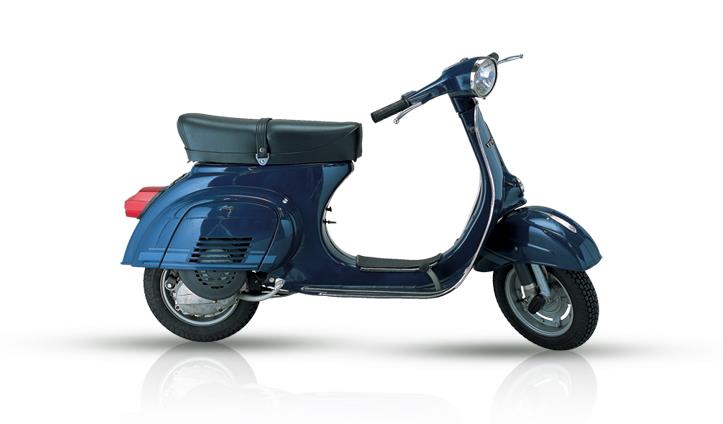
VESPA RALLY 200
1976
After the great success of the Vespa 180, in 1972 Piaggio developed a its first 200cc model. The response to this new product was amazing, with people waiting months to take delivery of one. Aesthetically, the Vespa Rally 200 is immediately recognizable by the white graphics on the chassis and housing, and at the time it had the most powerful engine with electronic ignition. Over 41,700 Vespa Rally 200 models were produced from 1972 to 1979.
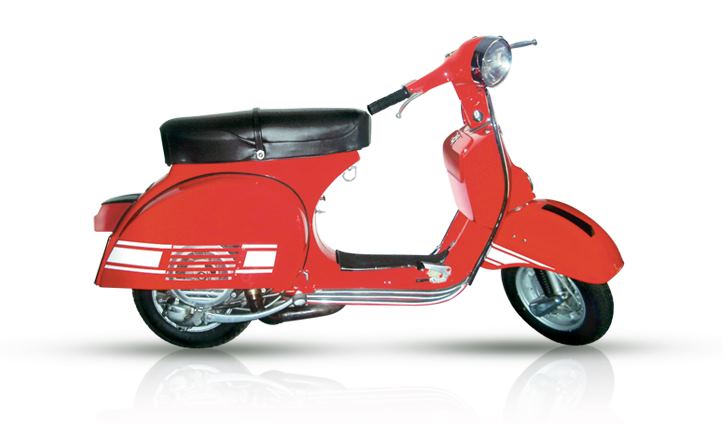
GIANT VESPA
1977
Representative of the PX Vespa and built for the presentation of the „New Line” in Paris in 1977, it was amended for the launch of the Vespa T5 years later. The giant Vespa was decorated by the artist Stefano Tonelli with urban graffiti; these pictures are on display in the Piaggio museum alongside the model which has now been restored to its original red color.
VESPA 100 SPORT
1978
Deriving from the Vespa 90, the 100 Sport model was developed due to legislation for mopeds in the American market. The rear lights, in particular, are larger. The capacity increase from 90 to 100 cc was achieved by increasing the cylinder bore.
VESPA P125X
1978
Presented at the Milan Show in 1977 as the new Vespa PX 125, this model came to be loved by the youth market. The square lines and the larger chassis make the PX instantly recognizable. There was a speedometer on the handlebars, which were completely redesigned. This model was highly innovative due to its updated front suspension with telescopic shock absorber.
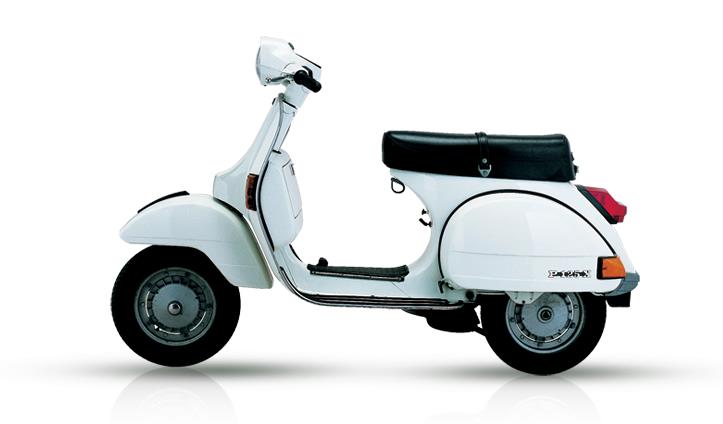
VESPA 50 S
1985
To meet the demands of some countries, Piaggio developed a faster 50 cc model. The engine produced a higher power model, while keeping the same bore and stroke as the standard model.
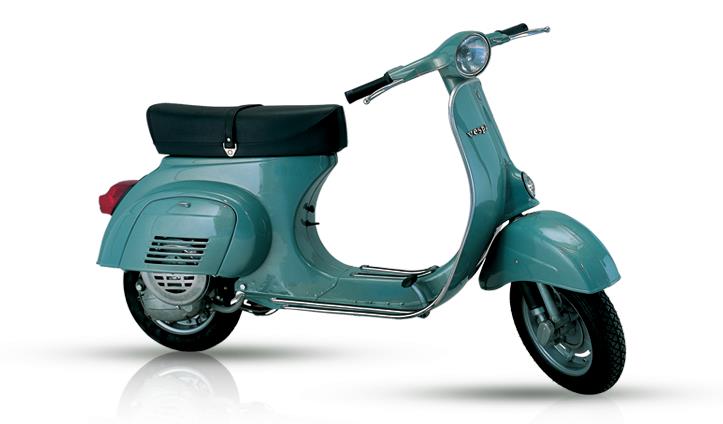
VESPA 125 T5 POLE POSITION
1985
Developed in 1985 as a completely new and redesigned Vespa, the 125 T5 Pole Position was equipped with a new engine that provided enhanced performance. The aggressive lines, the spoiler, the windshield and the digital tachometer enhanced its sporty character. At this time Piaggio had the difficult task of competing with fierce competition from Japan.

VESPA 50 SPECIAL REVIVAL
1991
Replicated in the early nineties to meet the many demands of fans, the Vespa 50 Special was most popular model among young people in the sixties. Appreciated throughout the world, the special model in 1991 was limited to just 3,000 units. It was aimed towards young riders who weren’t born during the 60s. This model was a legendary product and was even exhibited at the prestigious location of the Museum of Modern Art in New York. A Vespa 50 Special Revival was kindly donated to the Museum Piaggio „Giovanni Alberto Agnelli” by Christa Solbach (IVF President, International Federation of Vespa Club).
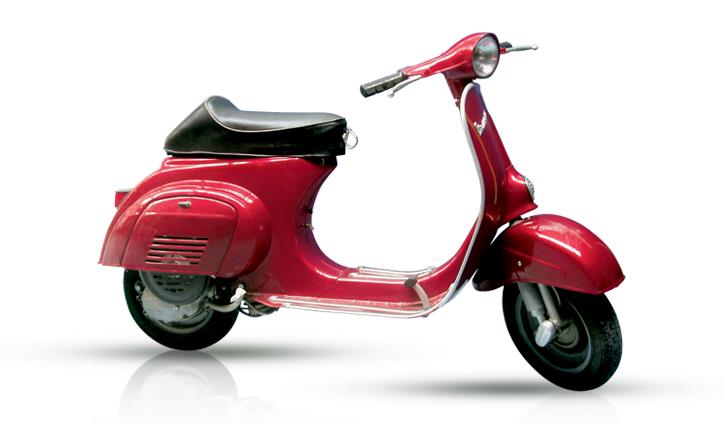
VESPA ET2/ET4
1996
Vespa enters the third millennium without losing its elegant lines and distinguishable design. However due to years of experience, it was more technologically innovative and had reached new heights in terms of comfort. The new generation of Vespa was available in three versions: Vespa ET4, equipped with an environmentally friendly 4-stroke 125cc engine, Vespa ET2, with a modern and reliable two-stroke engine, and the Vespa ET2 Injection, powered by the FAST ( Fully Atomized Stratified Turbulence). These were the first two-wheelers with two-stroke direct injection engines, reducing fuel consumption up to -30% and the emissions up to -70%.
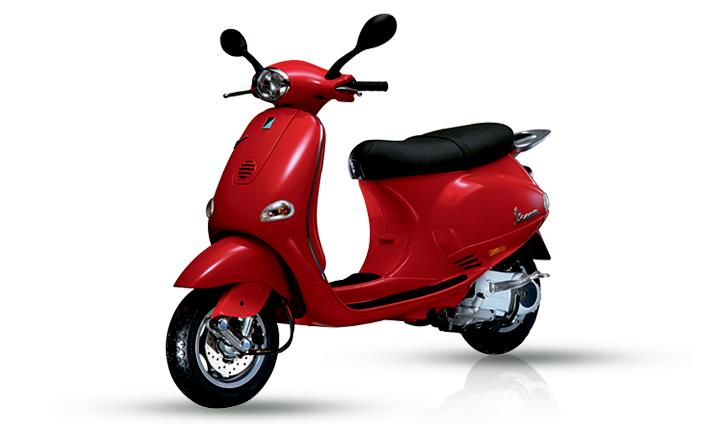
VESPA FERRARI ET4 150
2001
This model was thought as a homage to the Ferrari team for the victory in the Formula 1 World Championship in 2000. The vehicle was customized with the names of Montezemolo, Todt, Schumacher, and Barrichello. Naturally, it had a Ferrari red livery and a leather saddle utilizing the same material used to upholster the inside of a Ferrari.

VESPA TRAFELI
2003
Vespa PX became a true work of art, moulded and shaped by the creativity of Mino Trafeli. An exhibition of the same precious Trafeli was on display at the Museum Piaggio in 2003. This model was donated to the Museum’s collection by the artist that distorted the object to an improper form.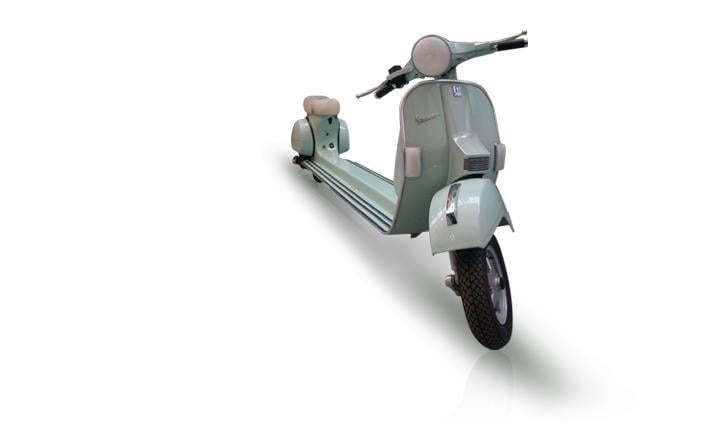
VESPA LX
2005
This was the return of the „vespino”, the small body model which was offered alongside the larger „vespone” for more than 40 years, in an extremely modern stylistic and technical key. Vespa LX replaced the glorious Vespa ET (more than 460,000 units sold since 1996) and is available in four modern and ecological engine sizes: 50cc two and four stroke, 125 and 150cc four stroke.
VESPA GTS 250 IE
2005
Fifty years after the launch of the Vespa GS (Gran Sport), the first sport scooter in history, and still a sought after treasure for collectors and fans, Vespa GTS 250 i.e. renews the GS blend of speed and style to become the fastest, most powerful, and most high-tech Vespa at that time. From November 2011, Vespa GTS “grew” to the 300 class with an avant-garde, extremely powerful four-valve, liquid-cooled engine with electronic injection. Vespa GTS’s braking is managed with a superb double disc braking system.
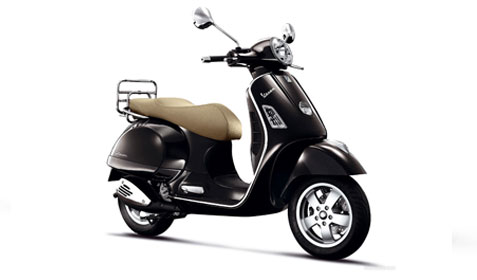
VESPA GTV – LXV
2006
Conceived to celebrate an absolute legend in the world of two wheelers, the Vespa LXV and Vespa GTV repeat and reinterpret the most distinctive elements of ‘50s and ‘60s styling in form and function. The Vespa GTV, available with 125 and 250 cc engines, stands out for its headlight mounted on the mudguard just as the original 1946 prototype. The Vespa LXV, offered with a choice of 50, 125 and 150 cc engines, is inspired by the smooth, essential lines of the Vespas of the 1960s, and features a sleek, minimalist look characterised by open handlebars and a two part seat.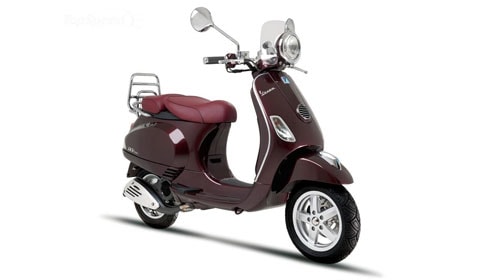
VESPA GT 60° 250 CC
2006
This is the gift that Vespa was determined to give its fans to celebrate the company’s sixtieth anniversary. With its premium materials and exclusive finish, this unique limited edition is made in a series of only 999 units, and is destined to become one of the milestones in Vespa’s long history.
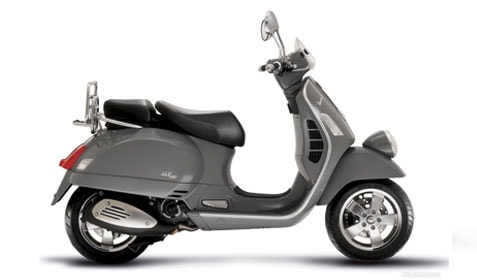
VESPA S50 – 125
2007
All the character of the sporty “Vespino” of yesteryear are revived by the brand new Vespa S. This fascinating blend of styles and memories keeps the soul of the youngest and most sporty of all Vespas alive in the present day. The Vespa S inherits its rigorously minimalist looks from legendary models of the 1970s like the 50 Special and Vespa Primavera.
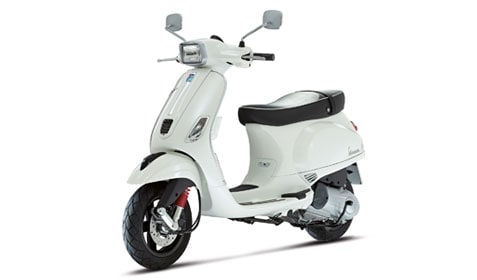
VESPA GTS 300 SUPER
2008
GTS 300 Super brings the exclusive elegance of Vespa to the over 250 class. The classic, unique Vespa style is combined with a distinctly sporty and modern personality, giving the clean Vespa lines a decidedly rugged look. With its sporty design, the Vespa GTS 300 Super embodies the style, convenience, safety and sturdiness of the Vespa brand. With new 4 valve timing, this brand new and feisty little powerplant has nothing to envy of its two-stroke counterparts (at 4.35 hp, it is the most powerful 50 cc four stroke on the market), yet its consumption and emission figures remain those of a four-stroke.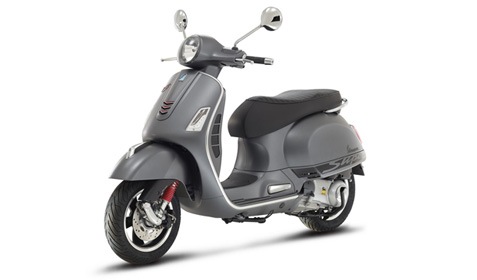
VESPA S50 – LX50 4V
2009
The new 50cc, four stroke, four valve engine lead to the rediscovery of an engine size which is „legendary” in Vespa history. With new 4 valve timing, this brand new and feisty powerplant has nothing to envy of its two-stroke counterparts (at 4.35 hp it is the most powerful 50 cc four-stroke on the market), yet its consumption and emission figures remain those of a typical four stroke. With this new engine, Vespa reconfirms a technological supremacy that has stood for over six decades.
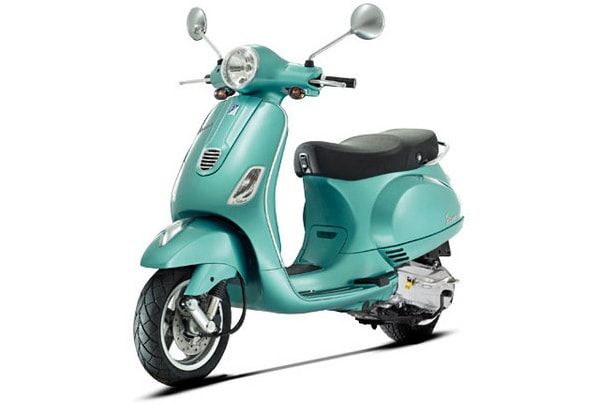
VESPA GTS ABS ASR
2014
In 2014, Vespa GTS is new and improved with the adoption of the most advanced technological electronic riding support systems: 2-channel ABS braking system and ASR traction control. Vespa therefore reaffirms its technological cutting-edge which has always marked its past and introduces one of the most modern, advanced and safest two-wheeled vehicles in the world.

VESPA 946 ARMANI
2015
To mark the year 2015 – the 40th anniversary of the foundation of Giorgio Armani and the 130th birthday of the Piaggio Group – Emporio Armani has designed a special version of the Vespa 946. In keeping with Armani’s signature subdued color palette, the designer came up with a special combination of greys with subtle hints of green visible only under particular light conditions for the project. The metal parts have a satin finish, and create an opaque effect in line with the finishing touches of the body. The words ‘Emporio Armani’ appear on the side, while the iconic eagle logo of the brand sits above the headlight.
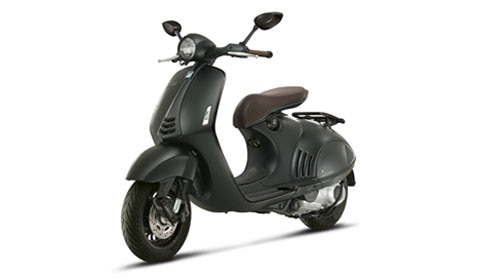
sursa: http://www.vespa.com/en_EN/Heritage.html
